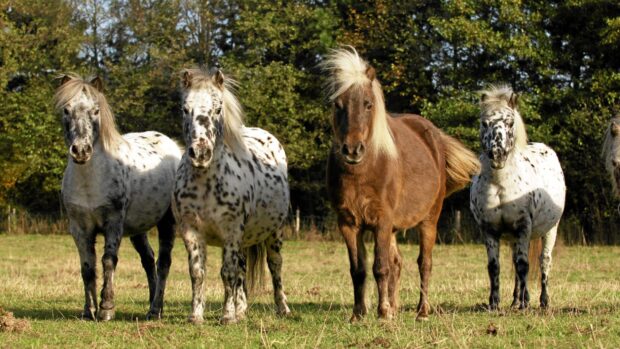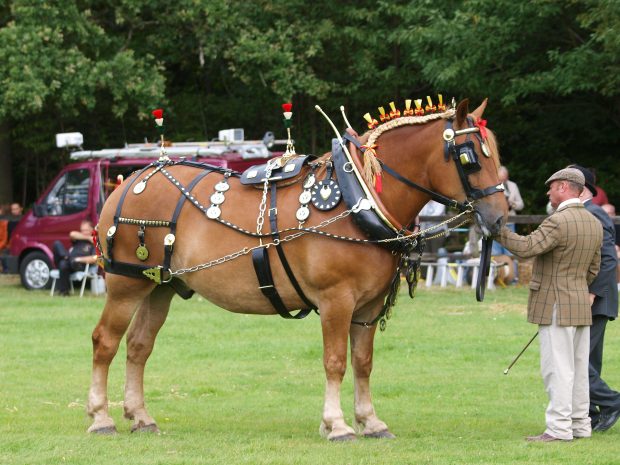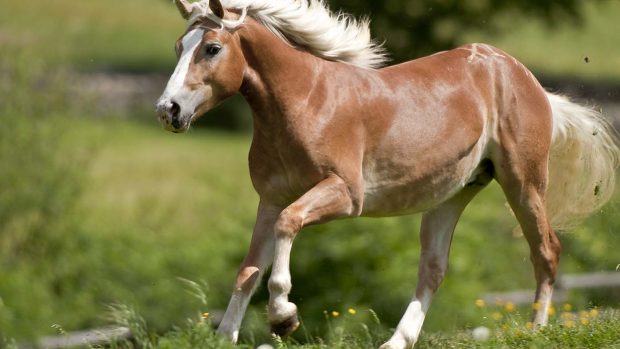The Morgan horse can be considered the ultimate all-rounder, proving excellent both under saddle and in harness. This American horse breed characteristically shows a kind and adaptable attitude, which makes them suitable as a family horse. With their typical height not much larger than a big pony, they are ideal for a range of ages and sizes of rider. Their unusual stance, high head carriage and long flowing tail, makes them distinctive aesthetically, and they are known for their presence and personality.
In this article: History | Uses | Conformation | Factfile

The Morgan horse is known for its presence and personality: they characteristically carry their head alert and proud, have high knee and hock action, and a long, flowing tail
History
All Morgan horses can be traced back to one sire – Justin Morgan – born in Springfield, Massachusetts, USA, around 1790. Originally called Figure, the colt was bought by a school teacher, Justin Morgan, by whose name the horse later came to be known. It is recognised as one of America’s first breeds, and Justin Morgan epitomised the ideal light horse for a pioneering nation. Today’s Morgans differ little from their progenitor.
Justin Morgan’s breeding is uncertain – it has been suggested he had thoroughbred, Arabian, Welsh Cob, Barb and even Friesian blood. One thing that is certain is his descendants inherited clean, straight limbs, muscular physiques and fine intelligent heads with large expressive eyes – all clear indications of quality.
In the 1840s a group of breeders began trying to locate descendants of the original Morgan horse. By the mid-1850s, Morgans were growing in popularity and fetching high prices throughout America.
The breed is relatively new to Britain, with the British Morgan Horse Society founded in 1975.
What is the Morgan horse used for?
Morgan horses are capable of adapting to most disciplines. They are suitable for both riding (Western and English-style) and driving, and their typically kind and bold personality makes them suitable for all the family.
While they are versatile, adaptable and willing to please, pure-bred Morgans are not currently well represented in the highest echelons of the Olympic disciplines, though they do compete in international driving events. They are able to perform a wide variety of tasks competently, whether it was as a cavalry horse in the early days of the breed, with stamina and willingness on the farm, to nowadays as a comfortable and enjoyable pleasure horse, competing in dressage, jumping, reining and more. It is the ultimate all-rounder.
Conformation
The breed possesses:
- Head: expressive with a broad forehead, large prominent eyes and a straight or slightly dished face
- Ears: alert, short, shapely and wide-set
- Throatlatch: deeper than other breeds and sufficiently refined to allow proper flexion at the poll
- Neck: relatively fine, arched and with a good topline; well-set on to an extremely sloping shoulder; well-defined withers, which must be higher than the croup
- Body: compact with a short, well-muscled back; tail set high and carried gracefully. Well-developed chest
- Legs: straight and sound with short cannons (and relatively long forearms) flat bone and an appearance of refined substance. Pasterns of sufficient length to provide springy step.
- Strong, round, well-proportioned feet
- Coat or eyes can be any colour, but the most common colours are bay, brown, chestnut and black
- Free flowing, soft and silky mane and tail which are never coarse
- Height: typically 14.1hh to 15.2hh but some individuals are smaller or larger
- Rhythmical movement with a fairly high knee and hock action
Morgan horse factfile
- They are often referred to as the “Artist’s Horse”, thanks to their fine, proud head and animated way of going
- American breeds the Saddlebred, Standardbred and Tennessee Walking Horse are all descendants of the Morgan
- Every registered Morgan can be traced back to one of Justin Morgan’s most famous sons: Sherman, Woodbury and Bulrush
- Before mechanisation, the US Army chose the Morgan as the mount of soldiers and as an artillery horse
- Breed classes are divided into park and pleasure and traditional American dress is worn for both. In the ring, park horses are judged on their exaggerated knee and hock action, while for pleasure horses, the emphasis is on a mannerly and comfortable ride
- The unusual stance, with the hindlegs splayed out parallel behind, is known as “parked out”. Many Morgans stand this way naturally, although the posture needs refining for the show ring
- Show Morgans are exhibited with exceptionally long flowing tails, which often trail on the floor
- Renowned for its stamina, the versatile breed can turn a hoof to most disciplines and is even used as a police mount in some American states
- The first official breed register was published in 1894 and since that time, more than 147,000 Morgans have been registered around the world

Morgans have natural ability to stand in a “parked out” stance, as required in the show ring
You may also like to read…
Get all the facts and figures about Andalusian horses

The original Black Beauty? All you need to know about the magnificent Friesian horse

¡Ole! Spanish, Iberian or PRE? What makes an Andalusian horse?

The Arabian horse: the history, hallmarks and heritage of this graceful breed

Subscribe to Horse & Hound magazine today – and enjoy unlimited website access all year round
Horse & Hound magazine, out every Thursday, is packed with all the latest news and reports, as well as interviews, specials, nostalgia, vet and training advice. Find how you can enjoy the magazine delivered to your door every week, plus options to upgrade your subscription to access our online service that brings you breaking news and reports as well as other benefits.





